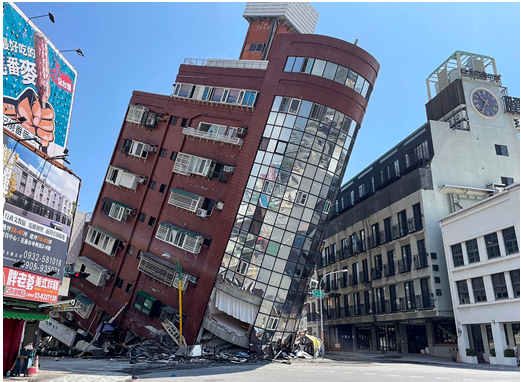Context:
On April 4, Taiwan experienced its largest earthquake in at least 25 years resulting in nine deaths and over 800 injuries.
More on the news:
- The earthquake, initially reported as 7.2 magnitude by Taiwan’s monitoring agency, was later recorded as 7.4 magnitude by the US Geological Survey (USGS).
- The epicenter of the earthquake was located just 18 kilometers south-southwest of Hualien County in eastern Taiwan. Multiple aftershocks, including one measuring 6.5 magnitude, were felt following the main quake.

- Taiwan’s susceptibility to earthquakes is attributed to its location along the Pacific “Ring of Fire,” where about 90% of the world’s earthquakes occur. This region is characterized by high seismic and volcanic activity due to the movement of tectonic plates.
- Over the years, Taiwan and its surrounding waters have experienced numerous earthquakes. Since 1980, there have been approximately 2,000 earthquakes with a magnitude of 4.0 or greater, and over 100 earthquakes with a magnitude exceeding 5.5, according to the USGS.

About Ring of Fire:
- The Ring of Fire is a horseshoe-shaped region around the Pacific Ocean characterized by a high concentration of volcanoes and frequent earthquakes
- Tectonic Plates: The Ring of Fire sits along the boundaries of several tectonic plates including the major plates such as Eurasian, North American,Antartic, India-Australia and minor plates that includes Juan de Fuca, Cocos, Caribbean, Nazca, , Philippin, etc which all encircle the large Pacific Plate, according to a report by National Geographic.
- It runs through 15 more countries including the USA, Indonesia, Mexico, Japan, Canada, Guatemala, Russia, Chile, Peru, and the Philippines.
- These massive slabs of Earth’s crust are constantly moving, grinding past each other, colliding, or subducting (one plate sliding beneath another).
- Taiwan experiences earthquakes due to the interactions of two tectonic plates — the Philippine Sea Plate and the Eurasian Plate.

Reasons for frequent earthquakes:
- Subduction Zones: A major cause of earthquakes in the Ring of Fire is subduction. As one plate dives beneath another, friction builds up along the meeting point. When the pressure becomes too great, the plates jerk suddenly, releasing energy that creates earthquakes.
- Transform Faults: In some areas, tectonic plates slide past one another, creating transform faults. These faults also experience friction and pressure build-up, leading to earthquakes when the tension is released.
Reasons for numerous volcanoes:
- Melting Rock: Subduction zones play a key role in volcanic activity. As a tectonic plate subducts, the intense heat and pressure cause the sinking rock to melt. This molten rock, called magma, rises towards the Earth’s surface, erupting as lava and ash when it reaches the crust or explodes through weaknesses in the crust, forming volcanoes.
- Volcanic Arc: The locations of volcanoes in the Ring of Fire are not random. The subduction process creates a line of volcanoes, known as a volcanic arc, on the side of the overriding plate where the subduction is occurring.
About Taiwan:
Geography and Location:
- Taiwan, officially the Republic of China (ROC), is an island in East Asia.
- Located at the junction of the East and South China Seas, it lies roughly 160 kilometers (100 miles) off the southeastern coast of mainland China.
History and Politics:
- The island has a complex history, with periods of rule by China, Japan, and indigenous peoples.
- Following the Chinese Civil War in 1949, the Kuomintang (KMT) Nationalist government retreated to Taiwan.
- The People’s Republic of China (PRC) claims Taiwan as a breakaway province, while Taiwan considers itself a sovereign state.
- Taiwan is a self-governing democracy with a vibrant multi-party system and a strong record of human rights.
- The status of Taiwan remains a sensitive issue in international relations.
Economy and Culture:
- Taiwan is a major player in the global economy, known for its high-tech manufacturing, particularly in semiconductors.
- It has a well-developed infrastructure and a highly educated workforce.
Also Read:
Energy Transitions Report to achieve India’s net-zero targets

